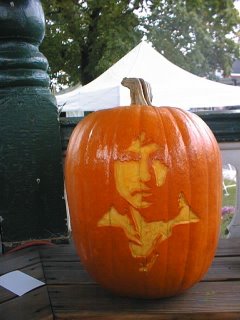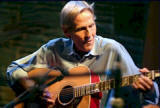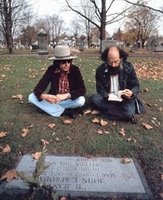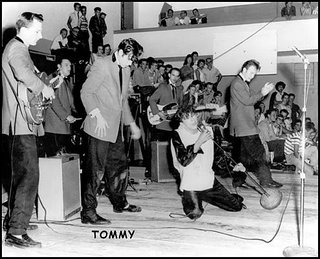Direct link to mp3
Subscribe to Dreamtime
Episode 19 - That Ol' Black Magic
We started with example of backmasking, where sounds meant to be played forwards are played backwards.
Sometimes deliberate, sometime only in the ear of the beholder, some bands who may – or may not - have used backmasking include Led Zeppelin, AC/DC, Pink Floyd, Queen, Black Oak Arkansas, Judas Priest, and of course, The Beatles.
The backmasking on the final verse of "Rain" was deliberate, but that led to the 19 and 69 "Paul is Dead" rumor when a Detroit City DJ claimed to have found backward messages in The White
 Album proclaiming McCartney's death. According to True Believers, Paul was replaced with the never-announced winner of a McCartney lookalike contest.
Album proclaiming McCartney's death. According to True Believers, Paul was replaced with the never-announced winner of a McCartney lookalike contest.Hmmm, I wonder if Heather Mills knows that story?
A more recent example of backmasking – or maybe reverse backmasking – was demonstrated by actor Michael Anderson on the Twin Peaks television series. Anderson would phonetically learn reversed speeches, record them, and his dialogue would then be reversed again, giving his speech a stuttering, spooky quality.
[I am the Arm]
Well, our turntables play in only one direction at Dreamtime, and its time to move forward. One of my favorite TV series when I was growing up was Bewitched, which ran from 1964 to 1972, roughly the same period when my hormones were raging at their highest levels. I wanted to be Darrin Stephens, not because the idea of coming up with weird advertising campaigns was attractive (even though it was). And not because the idea of commuting into the city every day and then returning to the 'burbs and a nightly martini sounded cool (even though it did).
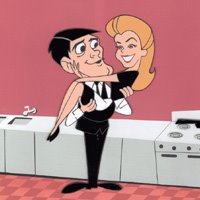 No. I wanted witchy nookie. Specific witchy nookie. Samantha Stephens. I wanted a wife who did wonderful mugging faces and double-takes. I wanted a wife who went "Welllll..." when pressed for an answer she didn't want to give. I wanted a wife who looked great in mini skirts, and even better in Capris. I wanted a wife who could wiggle her nose.
No. I wanted witchy nookie. Specific witchy nookie. Samantha Stephens. I wanted a wife who did wonderful mugging faces and double-takes. I wanted a wife who went "Welllll..." when pressed for an answer she didn't want to give. I wanted a wife who looked great in mini skirts, and even better in Capris. I wanted a wife who could wiggle her nose.Most of all, I wanted to be married to a witch. A specific witch. Hey, Sam, you know what? Darrin's an idiot. Babes, you want to do the nose twitch thing and put us on an island in the Caribbean with hot and cold running money, I'm for it. You want to do lunch in Paris, hang on honey, let me grab my beret. You don't want to do the chores when you know with a sweep of your arms and a zing musical cue everything's done? What, do I look stupid? Do your thing, and come back to bed, baby. There's lots of little Tabithas and Adams to be making.
Give me a witchy theme and I'm a happy camper. And here's Miss Peggy Lee, with that theme…
[Bewitched – Peggy Lee]
A lot of TV show themes had lyrics that were never used, including The Andy Griffith Show, Bonanza, and I Love Lucy
"The Strange Case of Dr Jekyll and Mr. Hyde" was written by the Scottish author Robert Louis Stevenson and first published in 18 and 86. It became one of Stevenson's best-selling works. 120 years later, you can still say Jekyll and Hyde, and everyone will know what you're talking about. Scores of works based on the Jekyll and Hyde theme have been produced, including both versions of The Nutty Professor, the 1996 remake, and Jerry Lewis' original.
In Jerry Lewis' original version, Lewis plays Julius Kelp, a totally social inept college professor who invents a formula that turns him into the cool hipster, Buddy Love. In his first transformation, Buddy turns up a night club populated by college students and proceeds to woo the pneumatic co-ed, Stella Stevens, with a swingin' version of "That Ol' Black Magic."
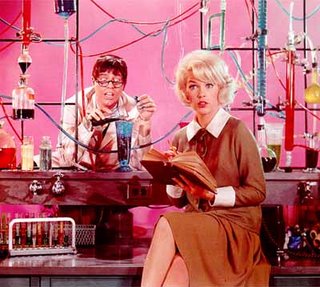
[Jerry Lewis – That Ol' Black Magic]
While Lewis has always denied that it was deliberate, the character of Buddy Love seems to bear more than a close resemblance to Lewis' then ex-partner, Dean Martin.
Me, I've always thought that Buddy Love was probably pretty close to what you'd get if you met the real Jerry Lewis of the `60s.
Next on the turntable is a tune from a group that never existed, The Five Blobs. The Five Blobs is really just one Blob, studio singer Bernie Knee who did all the vocal tracks for the theme song of the classic 1958 monster movie, "The Blob," starring Steve McQueen, and Andy Taylor's girlfriend, Helen Crump.
[Beware of the Blob – The Five Blobs]
 Beware of the Blob was one of the first songs turned out by Burt Bacharach, who teamed up with Mack David to produce it. Burt would later produce many hits with Mack's younger brother, Hal, songs including another tune originally written for the movies, The Look of Love.
Beware of the Blob was one of the first songs turned out by Burt Bacharach, who teamed up with Mack David to produce it. Burt would later produce many hits with Mack's younger brother, Hal, songs including another tune originally written for the movies, The Look of Love.The late `50s and early `60s were a scary period in America, with people facing real monsters like juvenile delinquency, the Atomic Bomb, and of course, the Red Menace.
Communists seemed to be everywhere, including under the bed, as a very young Bob Dylan relates in this song from his Halloween concert…
[Talkin' John Birch]
Y'know, I've been told I do a pretty good young Bob Dylan imitation. It goes like this…
[Fred does Bob]
What do you think?
If you watch The Wizard of Oz carefully, you'll notice that the Wicked Witch tells one of the flying monkeys that she had had sent "a little insect... to take the fight out of them," right before the Flying Monkeys attack Dorothy and her companions in The Haunted Forest.
That "little insect" was The Jitterbug, who would bite each member of the group and make them dance the Jitterbug until they were exhausted and could easily be subdued by the flying monkeys. Here's Judy Garland, Jack Haley, Bert Lahr, and Ray Bolger singing a segment from The Jitterbug...
[The Jitterbug]
The Jitterbug scene was cut from the final movie release, nobody is quite sure why. One theory has it that including a contemporary dance would date the movie too quickly. Another that the producers disliked "show stoppers," feeling that they slowed down what was already an overlong movie. In fact, for awhile, the studio considering removing "Somewhere Over the Rainbow" too, because it was another show stopper.
Glad they didn't.
Well, I see from the Witches' hourglass that, like Dorothy, my time has run out. So, until the next show, have a Happy Halloween and don't let the Jitterbugs bite.
Closing music: Martinibomb and the Coconut Monkeyrocket - Munster Beat!

